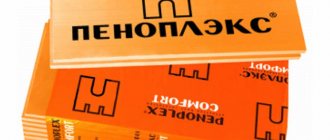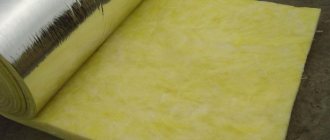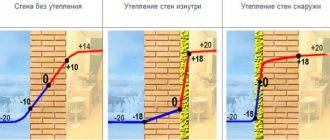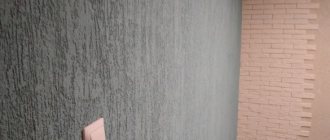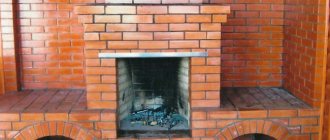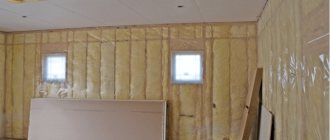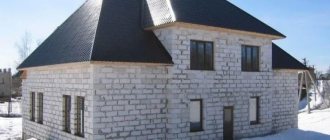Mulwatt
5832 0 0
Mullvatt August 28, 2016Specialization: Capital construction work (laying a foundation, erecting walls, constructing a roof, etc.). Internal construction work (laying internal communications, rough and fine finishing). Hobbies: mobile communications, high technology, computer equipment, programming.
Foam is not a means for cleaning a house, but a way to reliably insulate it.
I have never talked about foam insulation in my articles. And all because the implementation of such technology requires specialized equipment and certain skills in working with it.
However, foam insulation in home cylinders is so effective that it would be a crime to remain silent about it. Therefore, I will tell you everything I know about it, and you can decide for yourself whether to insulate the foundation, roof and walls yourself or entrust the implementation to specialists.
Features and Specifications
The installed foam insulation is a porous polymer mass.
The working solution is applied under pressure to the wall or ceiling, foams upon contact with air and hardens. Numerous gas bubbles provide thermal insulation and protect the premises from street noise and vibrations. Polyurethane foam, also known as polyurethane foam sealant, is a substance widely used in construction for fastening together individual parts of the connected structure, heat and sound insulation, sealing and filling voids that arise during the work process. Usually sold in metal cans, in which the foam itself and a mixture of liquefied gases are under pressure - the so-called. a propellant that serves as a buoyant force for the contents of the can. The versatility of this synthetic polymer makes it an indispensable assistant in many types of construction work and in almost any repair.
Of course, polyurethane foam sealant has its own characteristics and characteristics, which will be discussed below.
Useful video
Before starting construction of a building, it is necessary to carefully consider the issue of its thermal insulation. In this case, not only the walls, but also the entire structure should be insulated.
Today, the construction market is represented by a huge selection of thermal insulation materials, but foam deserves special attention. It allows for high-quality insulation, protecting the building from temperature changes, and provides a constant indoor microclimate at any time of the year.
High-quality insulation in cylinders: features of polyurethane
PPU is one of the most popular types of thermal insulation materials produced in cans. What else do you need to know about him?
Features and properties of polyurethane foam:
- The qualities of this insulation directly depend on its composition and the additives it contains;
- Using polyurethane, you can quickly and without much difficulty insulate a structure of any configuration;
- This material is not afraid of the chemical effects of alkali or acid, and is able to withstand dampness and is too tough for insects and rodents.
True, as an option you can use “Ekopen” - one of the varieties of polyurethane foam. With its help, you can safely insulate walls and roofs, and with increased vapor permeability. Eco-foam will perform well when insulating ceilings, attic or interfloor ceilings.
But it should be borne in mind that the use of Ecopen is not intended for external insulation of a building without a protective coating, since it is a rather sensitive material to the effects of precipitation and mechanical loads.
Reviews
Recently, most builders have chosen foam as the main insulation material. They attribute this to the high performance characteristics of the material. Judging by the reviews, the foam is easy to install, so it can be used at home to insulate balconies or loggias. The material has proven itself not only as a heat insulator, but also as an excellent fixative . Therefore, most homeowners, when carrying out repairs, choose it for attaching door and window blocks.
Residents of apartments in multi-storey buildings, where not only heat but also sound insulation is important, are also satisfied with polyurethane foam. Thanks to its unique structure, the mixture adheres tightly to the surface of the walls and ceiling, reliably protecting them from the penetration of extraneous noise. In addition, many consider the main advantage of foam to be its strength and long service life.
Stages of roof insulation with polyurethane foam
When applying the coating, you must follow the technology and sequence of work
Necessary tools and protective measures
To work you will need:
- reusable and or disposable spraying installation;
- mounting knife for cutting rolled and sheet materials and removing frozen excess foam;
- measuring tool for marking surfaces;
- painter's protective overalls with a hood and elasticated arms;
- tight shoes;
- safety glasses or face shield;
- respirator;
- gloves.
Preparatory work
During preparation, it is necessary to clean the surface to be treated from debris, dirt and remnants of old coatings.
Next, install the sheathing and metal profiles or wooden slats. Their thickness should match the planned thickness of the applied foam layer. In the future, the finishing trim will be attached to this frame.
The working solution is thoroughly mixed to the consistency required in the instructions.
Spraying material onto the base
The first layer of foam is applied to the prepared base. It is necessary to achieve a continuous application, closing gaps and filling uneven areas.
Spraying is done from top to bottom. If necessary, after the first layer has hardened, apply the second and subsequent layers. Each time you need to let the previous layer dry and set.
Excess insulation is cut off with a mounting knife flush with the installed sheathing.
If you plan to cover the insulation with a layer of plaster, a polymer or metal reinforcing mesh is mounted on the sheathing.
Application of fire retardant composition
Polyurethane foam is highly flammable and releases toxic substances when heated and burned. Therefore, the insulation layer is coated with a fire retardant compound. The composition must be selected specifically recommended for use together with polyurethane foam. It would be wise to choose it from the same manufacturer as the main material. The layer is applied with a sprayer or roller so that the coating is continuous and the entire insulation is protected.
Application
After about 30 cm, stop and see what layer of foam forms. If necessary, apply a little more foam on top of the first layer.
Over time, you will develop an understanding of the optimal amount of solution to spray.
But for pouring, it will be very problematic to correctly distribute the foam evenly throughout the entire space. The fact is that, in theory, you should first pour in the liquid, and then it, expanding, gradually becomes foam.
But the catch is that it is almost impossible to perform this procedure, since you cannot see what is happening inside. That is why it is recommended to install the hose in such a position that it points straight down, and then start pouring. So, the liquid will first fill all the cracks and niches from below, after which, expanding, it will move upward.
Material characteristics
Polyurethane foam (PPU) looks like a homogeneous structure of foam material, consisting of air bubbles filled with gas. Various versions of polyurethane foam are deservedly popular because they can be manufactured directly on the construction site. The most common method is to apply the material to the surface by spraying. Spraying is used for thermal insulation of houses, industrial workshops, pipelines, and in addition, it is actively used in the interior of premises.
Filling is used when it is necessary to fill a cavity between walls or a gap between installed finishing layers.
The thermal conductivity coefficient of the material is 0.023-0.025 W/mS. Teplis heat insulator is lightweight and can be easily applied to surfaces made of any materials (concrete, brick, glass, wood, aluminum, PVC).
Thanks to the optimal ratio of open and closed cells in the structure, the insulation “breathes”. Accordingly, the treated surface always remains clean and dry.
Other product benefits include:
- resistance to temperature changes;
- environmental friendliness;
- duration of operation (at least 20 years);
- seamless application, eliminating the formation of cold bridges;
- good sound insulation;
- low flammability;
- immunity from harmful rodents and insects.
Teplis polyurethane insulation is sold in 1 liter cylinders. Included with this product, the manufacturer offers to purchase a mounting gun with nozzles for uniform spraying.
Basement of a house with sprayed insulation applied
Cylinder assembly
The reason here is that polyurethane foam is sold mainly in small volume containers, approximately 200 and a maximum of 750 ml.
The largest of them are inexpensive, but they are enough to process only 1 square meter. m of any surface, but taking into account that the layer will be applied no thicker than 8 cm.
After insulation with this material, the thermal insulation of the surface will be several times lower in comparison with the use of the other two types of foam. The reason is that in such insulation half of the cells remain open, whereas in the same polyurethane foam the number of closed pores reaches 90%.
In addition, this process intensifies after the material reacts with moisture in the air.
The use of this insulation is common for sealing both window frames and during the installation of doors. It is also advisable to insulate the walls of a small area, for example, a loggia or closed balcony.
Features of insulation of various structures
Depending on the surface being treated, the order of the measures taken may be different. The advantage of polyurethane foam insulation is that it can be used for both horizontal and vertical elements. Insulating a house with foam has a high degree of adhesion to the surface, since the material penetrates into the most inaccessible places.
Insulation of floors
Can be done both from below and from above. For flooring above a cold basement, the most appropriate option would be to insulate the floor from below. Polyurethane foam is practically the only insulation that is convenient to work with in these conditions. To protect the attic floor, polyurethane foam is applied from the cold attic side.
Waterproofing and vapor barrier are not required during operation. It is recommended to carry out installation in the following order, regardless of whether insulation is performed from above or below:
- removing dirt and dust from the surface being treated;
- to increase adhesion, you can treat the surface with a primer;
- nailing slats or profiles, installing floor joists, between which heat insulation is sprayed;
- filling the space between the profiles with expanded polystyrene;
- finishing the ceiling or installing a clean floor.
Wall insulation
Insulation of walls with foam can be done from the outside and from the inside. External thermal insulation would be a smart solution, but if necessary, internal work is allowed, for example, with additional insulation after the facility is put into operation. The only differences are in the finishing.
The work is performed in the following order:
- surface preparation, cleaning from dirt and dust;
- marking the wall and installing vertical sheathing;
- filling the space between the frame with foam;
- installation of the facing layer.
Mansard roof
Insulating the space between the rafters with foam will allow you to choose the pitch of the rafters regardless of the dimensions of the material, as is the case with mineral wool. The insulation is installed in the following order:
- installation of elements of the rafter system and roofing;
- cleaning the base;
- spraying polyurethane foam between the rafters from the eaves to the ridge;
- installation of sheathing;
- ceiling cladding, such as plasterboard.
Scheme
An important point in the construction of buildings is the insulation of walls with foam using a special technology that provides for two installation schemes: external and internal.
If you do all the work yourself, then first you need to lay polystyrene foam on the outside. Then high-quality waterproofing is installed from the inside, after which everything is sealed with foam insulation.
When carrying out external insulation, it is necessary to completely eliminate the appearance of an air gap, otherwise condensation will collect on the surface, and fungus or mold will appear in the future.
To do this, foam is applied to walls lined with polystyrene foam from a can by spraying. The mixture should be applied evenly to the surface.
Kinds
It's no secret that modern insulation manufacturers offer the widest range of sealants to choose from. Let's together try to understand the abundance of types of polyurethane foam and see which types of the required substance will best serve a particular purpose.
Polyurethane foam differs in several ways.
Type
Household
Pros: no special equipment is required to work with household foam. It can be easily distinguished from a professional one by the external type of can: at the end of the container there is a special valve on which a lever with a plastic tube is attached.
Cons: can only be used to fill small voids or cracks; it is not used for installation, since it almost always requires trimming - the volume of this type of sealant is usually higher than the volume of the space it fills.
Professional
Pros: higher coefficient of primary expansion than the previous type, increased elasticity and finer structure. The supply of material can be controlled, so it is placed more accurately than household material, evenly filling the required volume. It is also impossible not to mention that professional polyurethane foam can be easily attached to almost any surface.
Cons: A nail gun is required for a professional look. However, given the versatility and wide scope of application, this minus is very relative.
By temperature of use
Summer
Summer polyurethane foam is recommended for use at positive temperatures – from approximately +5 to +30. At low ambient temperatures, the yield of useful substances from the can decreases, and the degree of expansion drops significantly. Work at elevated temperatures should also not be carried out due to the characteristics of the prepolymer, whose viscosity in such cases is significantly reduced.
Winter
Typically used at temperatures from -10 to +40 degrees. However, there are some types of foam that allow you to work even at -20 - for example, Tytan Professional 65 sealant. After hardening, the winter type can easily withstand temperatures of seventy degrees. Suitable for a barrel in which any substance can be stored.
All-season (or universal)
In fact, it has almost the same temperature range as winter and is not always classified as a separate group. Work with it is carried out at temperatures from -15 to +30 degrees.
By the number of components in the can
One-component
It is quite widespread and has a relatively low cost. The polymerization reaction occurs with the help of water. The shelf life does not exceed one year.
Pros: low cost, ready for use immediately after purchase, easy to use.
Cons: short shelf life.
Two-component (structural)
Water does not take part in the reaction. It is replaced by a special component, which is located in a small hermetically sealed container inside the cylinder itself. Its cost is higher than that of a single-component one and, as a rule, it is sold in small-volume cylinders (usually 220 ml), because the solidification time of the substance after mixing the components is short and amounts to ten minutes.
Pros: neat filling of voids.
Disadvantages: high cost; when producing a polyurethane mixture, it is necessary to strictly adhere to the established proportions.
According to the degree of flammability
- Class B1 – fire-resistant and fire-resistant. It usually comes in a pink or bright red hue - dyes are added specifically so that when applied, the type of composition is immediately visible.
- Class B2 - self-extinguishing, as the name implies, it does not support combustion.
- Class B3 – combustible PPU foam with zero fire resistance. Reviews are mostly positive.
Making molds at home
PVC tiles: pros and cons
To obtain a quality casting, you must follow the following guidelines:
- The model and frame of the mold are prepared to be filled with polyurethane foam. The form is a natural material (stone or wood, plastic, plaster or concrete). Before pouring, the product and base must be firmly fixed and treated using special lubricant. This will help you release the mold without any effort after drying. The base is leveled.
- Preparation of ingredients. Before mixing, the elements must be prepared. All components are thoroughly mixed separately in advance. It is necessary to prevent contact of materials with moisture. Not recommended for use in rooms with high humidity.
- Each component is weighed separately. The ratio of elements is calculated directly by mass. The amount of liquid material remaining on the walls of containers used for mixing is taken into account. To calculate the required mass of components for the mold, the specification for the material is studied. Usually it comes with polyurethane foam.
- Mixing elements. Taking into account the quantity, 2-component polyurethane foam is mixed by hand using a spatula or other profile hand-held device (weight up to 5 kg). As an alternative, you can use electrical equipment, you can take a construction mixer or a drill with a mixing attachment. Mix the prepared elements thoroughly for 1 minute until a homogeneous mixture appears. The emphasis is on the adjacent walls. In order not to use a poorly mixed compound during pouring, you need to pour the finished mixture into another container and mix again. The volume of the latter should be twice as large as the previous one, since the polyurethane foam will increase in size.
- Vacuum processing of polyurethane foam before pouring the mold. To displace air from a liquid polyurethane mixture, you need to send it to a degassing device. After 2 minutes the air will be displaced and the material can be used.
- Pouring polyurethane foam into the base of the mold. The liquid material is poured from the corner evenly, eliminating the penetration of air. The pouring is controlled so that the level of the mass rises equally on each side during casting. The mass is poured until the polyurethane layer is sufficient.
- Seizing the material. The hardening process will take 1-2 days, taking into account the material itself and the thickness of the walls. The model remains inside until it dries completely or is removed when it has frozen sufficiently (after which it is dried). Similar actions are carried out with the frame. The product will dry faster at high temperatures, up to 70 degrees.
Preparation of polyurethane
Polyurethane foam for the production of molds is a polymer material that is obtained by mixing polyol and isocyanate. Elastic and solid, it is popular in construction and restoration work. The main emphasis is on basic safety rules. It is necessary to prevent penetration of the compound onto the open surface of the skin and into the eyes.
Advantages and disadvantages of this type of insulation
The undeniable advantages of the substance in question, which the manufacturer usually indicates on the packaging, include:
- high degree of adhesion - that is, its ability to firmly attach to many surfaces. The exceptions are Teflon, silicone, ice, polyethylene and oily surfaces;
- heat resistance (usually ranges from -45 °C to 90 °C);
- cured polyurethane foam is a dielectric (does not conduct electric current);
- fairly fast hardening speed - from eight minutes to a day;
- high moisture resistance;
- lack of toxicity (of course, after final hardening);
- a small percentage of shrinkage (no more than 5%) throughout the entire period of operation;
- chemical resistance;
- high strength;
- long service life of the material (up to half a century).
Also no less important characteristics are:
- The total volume of sealant output is calculated in liters and refers to the amount of foam coming out of a unit of container. This characteristic is affected by ambient temperature, humidity and windiness.
- Viscosity mostly depends on air temperature. Temperatures above (or below) certain limits specified for each type of foam will negatively affect the viscosity of the substance. This is bad for masonry.
- Primary and secondary expansion. Primary expansion is the ability of the composition to expand immediately after leaving the cylinder in a very short time interval (up to sixty seconds). In this short period of time, polyurethane foam sealant is able to increase in volume by 20-40 times. Secondary expansion refers to the ability of a synthetic polymer to expand for a long time before polymerization finally stops.
High-quality polyurethane foam has a pleasant light yellow or slightly greenish color; it does not flow down when applied to the surface and is even suitable for the roof. It is not eaten by rodents and insects, and does not harm the environment. When hardened, the substance turns into a durable, porous, seamless material that is quite moisture-resistant and has excellent insulating properties.
It is important to note that under the influence of solar ultraviolet radiation, this insulating material is subject to rapid destruction - first it darkens and then becomes brittle. Never forget to plaster the foam-filled area after it has hardened.
Otherwise, it may simply turn into dust.
Polyurethane foam is suitable for insulating a frame house. It will serve as a special air gap.
Experts' estimates vary, so let's try to draw a line and compare all the pros and cons.
Advantages
- The porous structure prevents the accumulation of steam inside penoizol.
- Significant service life - from 50 to 60 years.
- Prevents the colonization of microbes and rodents, does not rot.
- Not subject to spontaneous combustion.
- Resistant to hazardous environmental influences.
- Possibility of quick installation.
- Does not release toxic substances after hardening.
- Insulation can be done with your own hands.
Minuses
- It takes a long time to dry. Complete drying of a not too thick layer takes at least two days.
- During polymerization, harmful formaldehyde is released.
- Does not adhere well to dirty surfaces.
- If necessary, dismantling the coating is very difficult.
- During the cold season, working with this material becomes very difficult.
| Application thickness, cm | Price in rub. per cube, density 36 kg/m3 | Price in rub. per cube, density 53 kg/m3 |
| 3 | 450 | 800 |
| 6 | 900 | 1550 |
| 10 | 1500 | 2600 |
Insulation using ready-made sheets:
| Slab thickness. cm | Price in rub. for 1 m2 |
| 10 | 1200 |
| 15 | 1800 |
| 20 | 2300 |
Insulation by pouring method:
| Type of work | price, rub. for 1 m3 |
| Pouring on the object under construction or into existing holes | 1500 |
| Filling with drilling | 1500 200 per hole |
As you can see, foam is not an inexpensive method of insulation, but taking into account the subsequent savings on heating and the speed of application, it is possible to reduce the overall cost of building a building. In addition, the price may be partially covered when carrying out insulation work with your own hands.
Cost of work
| The name of the manipulations performed. | Price per 1 cubic meter/rub. | Price per 1 square meter/rub. | Spray/plate thickness |
| Spraying penoizol | 36 kg – 450; 53 kg - 800; 36 kg - 900; 53 kg – 1550; 36 kg – 1500; 53 kg – 2600; | 0 0 0 | 3 6 10 |
| Purchased foam sheets | 0 0 0 | 1200 1800 2300 | 10 15 20 |
| Pouring during construction | 1500 | 0 | 0 |
| Pouring into prepared cavities | 1500 | 0 | 0 |
| Filling with cavity drilling service | 1700 | 0 | 0 |
*
Features of insulation
To independently insulate a house with foam, you need a protective suit. Foam is usually sprayed from a can onto the entire surface of the facade; it fills the voids between walls, rafters, and beams.
There are many advantages to this type of wall insulation with foam in the air gap. The main ones include:
- vapor permeability;
- fire resistance;
- ability to increase in volume;
- resistance to various types of mechanical stress;
- the upper temperature limit remains within +80 degrees.
Foam is often used to seal cracks that remain after installing plastic windows. Due to this, the thermal insulation in the apartment also increases. It is convenient to use a pneumatic gun for insulating not only windows and external walls, but also foundations, loggias and balconies, and pipes.
After treatment with foam insulation for walls, the facade turns out perfect - without visible joints or seams. One cylinder contains on average 600-700 ml of the composition, which is enough to treat a square meter with a layer up to eight centimeters thick. Operating such a gun is very simple: first, a full cylinder is inserted into it, then you need to point it at the surface to be treated and pull the trigger. On average, the applied composition hardens within 24 hours.
Advice from professionals
PPU insulation is considered a complex technology. It is better to entrust the work to hired specialists. If you decide to master this “art” on your own, you should listen to the advice of professionals:
- When mixing polyurethane foam with water, the ratio is 1:1.
- If the working mixture has darkened, the proportions are not maintained correctly. The properties of the insulation will deteriorate.
- When insulating in the middle zone of the attic, the thickness of the polyurethane foam is applied at least 15 cm.
- Insulation is best done in warm weather, when the air temperature is above + 10 ° C.
- During spraying, moderate humidity is created in the attic. Excess moisture is not allowed. The insulation can peel off from the surface or harden with large air bubbles.
- During operation of spraying equipment, ventilation is provided in the attic.
- Spray foam from a gun, moving from bottom to top. The nozzle is removed from the insulated surface at a distance of 50 cm.
- In one pass, a layer of the required thickness is immediately sprayed. You cannot use a gun to return to areas of foam that have not hardened.
Upon completion of work, the equipment is washed. If polyurethane foam accidentally sticks to the body, carefully remove it with a solvent.
Types of material and their properties
Foam heat insulators vary in their composition and application method
Liquid penoizol
This popular material is used to insulate floors and walls. It has the following advantages:
- high-quality adhesion to most building materials;
- small amount of preparatory work;
- seamless and jointless coating;
- good vapor permeability;
- high penetrating ability;
- possibility of filling hard-to-reach volumes;
- resistance to fungus, microorganisms and mold;
- environmental friendliness.
The material also has disadvantages:
- linear shrinkage;
- strong unpleasant odor during application;
- hygroscopicity, additional water vapor barrier is required;
- fire hazard; when heated, toxic substances are released.
Roof insulation can be done using liquid penoizol.
Penoizol requires an additional fire retardant coating; it is better to use it for external insulation of the roof of a house.
Polyurethane foam (PPU)
Closed-cell polyurethane foam insulation is also deservedly popular among homeowners. Experts highlight the following advantages inherent in the material:
- applicability over a wide temperature range;
- compatibility with most popular building materials;
- ensuring the tightness of the sprayed coating even with a complex roof configuration;
- low thermal conductivity coefficient;
- resistance to biological influences: mold, microorganisms, insects, rodents;
- low density of the material and, accordingly, a small additional load on the roof;
- resistance to solvents and other active substances;
- ability to withstand compressive and tensile loads;
- low vapor permeability, no need for additional vapor barrier;
- minimal hygroscopicity;
- excellent noise insulation performance;
- long service life comparable to the service life of insulated structures.
There are PPUs and a number of disadvantages:
- high activity of the working staff, harm to exposed skin and respiratory organs;
- the need to use protective clothing, masks and respirators;
- vulnerability to sunlight, especially ultraviolet rays, necessitates protecting the coating with an additional layer of mastic or plaster;
- releases harmful substances when heated;
- highly qualified worker applying the coating is required;
- high cost of equipment for applying the material.
The last two factors make it difficult to apply polyurethane foam yourself. Even disposable installations, already charged with a certain volume of working solution, are expensive. If the home owner does not have experience in successfully using them, it is better to turn to professionals and insulate the roof with their help. You will be able to save your nerves, money and time.
Do-it-yourself DUGA® P1 equipment
The need to insulate your own home, cottage, garage with high-quality durable material with a high thermal insulation coefficient, the absence of cold bridges, a simple and reliable method of fastening/application, as a result of considering all the options, often leads to the decision of self-spraying polyurethane foam. After choosing polyurethane foam as thermal insulation, there is a need to purchase ready-made equipment for spraying it, or a desire to make equipment for polyurethane foam with your own hands. Considering the unreasonably high cost of so-called “one-time installations” for spraying polyurethane foam with the impossibility of subsequent use, a reasonable choice would be to purchase an inexpensive ready-made installation, with which you can spray polyurethane foam not only on a specific object today, but also to use it in the future, or even try assemble the equipment for the power supply unit with your own hands. Technically, at first glance, an installation for spraying polyurethane foam is really not anything complicated: a drive, pumps, a sprayer. However, often numerous attempts to make equipment for PPU with your own hands lead to unplanned results: the components “press” each other, a stable required ratio is not ensured, pumps that are not intended for pumping PPU components leak and jam, the sprayer requires a lot of air and does not provide high-quality mixing and sprayed foam onto the surface. In addition to wasted money and lost time, an installation assembled from unsuitable components not only does not fulfill its direct task, but also discredits the very idea of thermal insulation with polyurethane foam due to total savings and the lack of the required technical knowledge and experience necessary when designing any equipment.
For those who want to assemble equipment for the PPU with their own hands and, thereby, reduce the cost of insulating their home, the Vladimir Construction Equipment Plant offers a choice of two solutions:
1. kit for self-assembly of equipment for the DUGA P1 power supply unit:
The cost of such a kit, due to reduced production costs, is lower than the price of a finished installation and amounts to 56,920 rubles including VAT. The kit includes all products and parts that are used to assemble the DUGA P1 equipment, in addition, the kit includes hoses for sampling and supplying components, remote control, spare parts, instructions for assembling and using the installation, a passport, technological instructions for polyurethane foam.
By purchasing a factory kit for assembling equipment for the do-it-yourself control unit ARC P1, you receive:
It is also necessary to understand that the quality of assembly and configuration of the equipment, ensuring the production of polyurethane foam with the necessary characteristics in this case, lies entirely with the buyer. The factory warranty valid for finished DUGA equipment does not apply to the purchased kit for the reason stated above.
2. Do-it-yourself household installation for applying polyurethane foam ARC P0
This option seems optimal for most people who want to independently insulate their home, garage, bathhouse, extension, etc. with polyurethane foam. By purchasing such an installation, you receive a complete set of high-quality factory equipment for applying polyurethane foam yourself, including: supply hoses, a pumping unit, supply hoses for components and compressed air, a professional spray gun, detailed instructions for working with equipment and polyurethane foam. The unit has a full factory warranty - 1 year, is equipped with high-quality gear pumps of our own production, designed to work in an environment of PPU components. You can watch a video of our clients insulating their homes using the DUGA P0 installation on our YouTube channel. You can learn more about the installation on our website: household installation ppu DUGA P0.
"VZSTO" Design and production of innovative equipment for construction, road and repair work, as well as work related to construction chemicals, including waterproofing and thermal insulation
Types of foam insulation
There are 3 types of foam:
- Assembly room.
- Polyurethane, consisting of 2 substances.
- Liquid polystyrene foam - penoizol.
Other types, the packaging of which clearly indicates the scope of application.
Polyurethane foam in cylinders
This is a one-component thermal insulator. Insulation can be carried out independently.
Types of polyurethane foam:
- façade – having a large temperature range. It can withstand minus and plus temperatures;
- ordinary - for sealing cracks, sealing seams;
- with special strength;
- glue-foam.
A construction gun is used to apply the material.
Penoizol
Penoizol is similar to polyurethane foam, but it has a different composition. It has a low level of density, does not allow cold, sounds, or moisture to pass through. It is most often used to insulate houses.
To apply the material you need equipment and dry, warm weather. After completing the work, it takes 5 days for complete drying, only finishing work is carried out with topcoat.
Spray polyurethane foam
Polyurethane foam consists of 2 substances. This is the best material for thermal insulation of a building. Cylinder equipment is used for installation. The material on the surface hardens within 10-20 minutes. The structure is closed cells that have minimal thermal conductivity, noise insulation, and moisture penetration.
One layer of applied material is 6 cm thick. Sometimes after complete hardening, a 2nd layer is applied for strength.
Is it possible to increase sound insulation in this way?
The foam has sound insulation properties. This is affected by:
- The thickness of the applied insulation layer reflects the incoming noise.
- Elasticity absorbs vibration from sounds.
- The tightness of seams and cracks prevents noise from penetrating into the room.
But the foam in the cylinders does not have the same characteristics as the material sprayed through the equipment.
The only type of foam in cylinders that has good performance is MAXFORTE SoundFLEX.
Today, foam is widely used to insulate walls indoors and outdoors. It is used in attics and basements, attics and loggias. Insulation of pipelines and chimneys is carried out.
The material has many positive aspects and has good sound insulation properties. When using insulation, you should familiarize yourself with the application method and also think about the cladding.
Is penoizol harmful to health?
After testing, Russian manufacturers were convinced of the safety of using penoizol. There are certificates confirming this. But polystyrene foam is prohibited in Canada and is not used in the USA as insulation. In the UK, safety guidelines are followed regarding the use of urea foam as a toxic substance. The problem lies in the concentration of formaldehyde, which is released during polymerization. At high concentrations in the air it causes allergies and tumors in the future
Therefore, it is very important to use high-quality materials and adherence to pouring technology. In high-quality products and in the hands of craftsmen, the minimum content of formaldehyde is safe
Application of open cell foam
It must be remembered that if the attic will be used as a living space (and not a dry storage area for things), then the ceiling on the inside will need to be finished with a slope (for example, with plasterboard).
Most often, metal hangers are screwed to the rafters, to which, after applying foam plastic, a standard mesh of steel profiles will be attached, and plasterboard to it.
- When using open-cell foam, there is usually no need to install a vapor barrier film on the room side.
- However, it is necessary to ensure that water vapor can penetrate from outside.
- Consequently, it can come into contact with a highly vapor-permeable roofing film (the so-called membrane), but it is better to leave a ventilation gap between the foam and the formwork made without gaps from boards or wooden panels, and especially covered with bitumen paper.
Contrary to popular belief, wood has a very high resistance to diffusion. Contact of the foam with the formwork will prevent water vapor from escaping.
What is better - penoizol or polyurethane foam?
In order to understand which material is of the highest quality and strongest, it is necessary to compare them.
Thermal conductivity when installing installation insulation.
In this case, polyurethane foam takes first place, since its coefficient is higher than that of penoizol.
Density.
Foam also wins. Unlike penoizol, it is harder and has a structure of increased density.
Resistant to liquids.
Due to the high density of the PPU foam material, liquid does not allow liquid to penetrate into its structure; the first material, on the contrary, is prone to exposure to moisture and its absorption.
Resistant to fire.
Penoizol is a material that does not ignite at all, and foam is susceptible to melting and releasing harmful substances.
Life time.
In this category, both materials are equal; their optimal service life is about 50 years.
Price.
Penoizol is slightly cheaper than PPU foam.
Cutting off excess material for further processing.
Thermal insulation of PPU roofing: your benefits, our efforts
For construction organizations - thermal insulation of PPU roofs and waterproofing of roofs of newly constructed or reconstructed facilities according to your or our turnkey project. You are getting:
- reduction of construction time;
- The guarantee covers the period of liability of the developer (performer of the work).
Owners of industrial buildings - insulation of the roof of an industrial building. You are getting:
- thermal insulation of roofs in any condition, the ability to postpone the replacement of the existing roof covering;
- carrying out work without disrupting the operation of the enterprise.
Management companies, housing and communal services organizations and municipalities - insulation of roofs of apartment buildings, public and administrative buildings. You are getting:
- guaranteed compliance with the requirements of Federal Law N 261-FZ “On energy saving and increasing energy efficiency...”;
- “minimal presence effect” during work - no disturbance for residents, employees of organizations, customers, etc.
Insulation process
Do-it-yourself foam coating is within the capabilities of a home DIYer with basic spray painting skills. When working with entry-level household installations, as a rule, one person can handle it. When installing sheathing and when working with high-performance devices with long hoses, an assistant will be required to carry them, as well as move containers with components.
Preparing to start work
Before you begin, you need to prepare the surface for coating. You should remove old wallpaper, paint and anything that might prevent the foam from adhering to the surface.
Next, in increments of 50 cm, vertical guides are attached to the wall - wooden blocks or a metal profile. They are designed for fastening finishing materials - drywall, lining or others. If there is no decorative coating, the guides are not installed and the foam is sprayed in a continuous layer.
All work on laying communications - electrical and pipelines - must be completed before spraying begins. It is recommended to lay wires in corrugated plastic or metal sleeves.
Before you start covering the wall with foam, you should also make sure that there are no air bubbles left in the hoses and cylinders.
Continuous wall covering
Where can it be used?
You can insulate with polyurethane foam both residential or industrial buildings (inside or outside), as well as window or door openings, as well as fill voids formed in the walls when laying communications and pipes.
The miracle sealant easily fills even small gaps, preventing the formation of insidious drafts. Walls, floors and ceilings can be easily insulated. It protects the tree from rotting and fungal mold. Iron – from corrosion. The environmental friendliness of the sealant allows it to be used even in such matters as insulating a nursery. Therefore, if we return to the topic of our article: “Is it possible to insulate a house using polyurethane foam? “- the answer will be definite. It is possible and even necessary! Of course, the high price of polyurethane foam sealant may scare you away, but the advantages mentioned above will definitely be worth the money you spend on insulating your home. However, one should not forget about one nuance - the use of this type of insulating material makes the insulated room almost airtight, which means that the building or room must have well-thought-out ventilation so that problems of stuffiness or stale air do not arise.
Polyurethane foam is suitable for insulating hangars, garage doors, garages, facades, windows, as well as balconies and bathtubs. Using the material, you can insulate the area between the walls between the brick and the block. Waterproofing with it from the inside and on the roof is more reliable.
To learn how to insulate a balcony with polyurethane foam, see the following video.
